“Okay people, please clap or do something, because this seems very awkward to me” This is how artist, Bonnie Mohr, describes the long pause of silence that was the initial reaction of the large crowd present for the June 29th unveiling of the Ideal True Type Holstein Bull and Cow paintings at the Holstein USA annual meeting. .”I am much more at ease in my studio or with a small group of people.” Explains the well-known agricultural artist but she needn’t have worried. As with any supreme achievement the first reaction is one of awe. The crowd was initially busy studying the paintings but then broke into enthusiastic and sustained applause. Still, Bonnie is modest, “I think they were well received…”
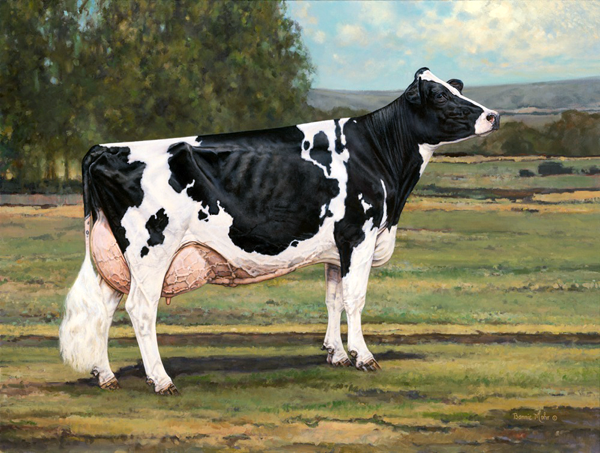
Ideal True Type Holstein Cow
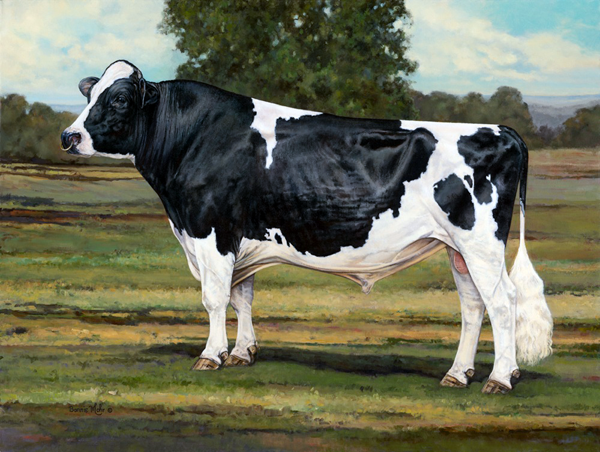
Ideal True Type Holstein Bull
Everyone loves to look at beautiful cattle and, as you would expect, the paintings indeed were well received. As summer slips into fall, we begin looking forward to the show season and parades of beautiful cows to celebrate. Of course, if you can’t wait for Madison or the Royal Winter Fair, there is an alternative. At The Bullvine we have celebrated graduations, engagements, new homes and new babies with the beautiful animals painted by Bonnie Mohr. And now with these commissioned paintings, Bonnie turns cow science into cow art for everyone to collect, admire and strive for.
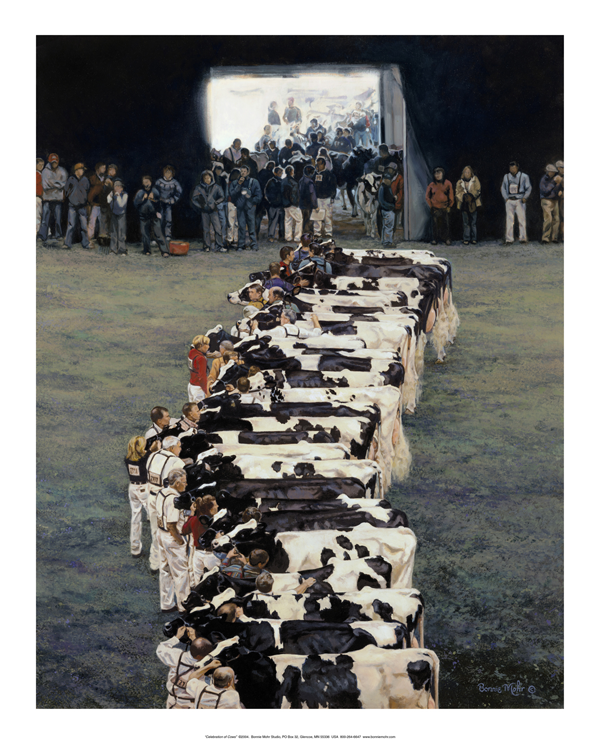
Celebration of Cows
A labour of love. The paintings were commissioned by Holstein Association USA. Discussions about what the new Model cow and bull would look like began at World Dairy Expo in 2011. She outlines the process. “The month of December was preliminary painting sketches, and January through June 1st was spent painting the two pieces. Since they were very large -each painting measures 36” x 48” – and with extreme detail in the animals, it took longer than a normal painting time. I would guess I averaged 30-40 hours per week of painting time from January 1st to June 1st.”
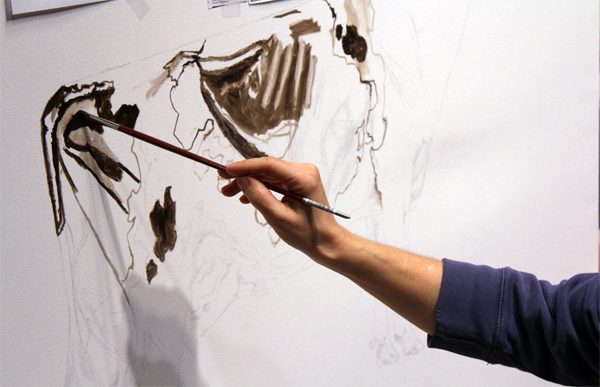
Ideal True Type Holstein Cow – The Beginning
Matchmaking. From the outside, it might seem unusual for an artist to work with input from others or, in this case, the True Type Model Panel. However Bonnie says that was never a problem. “Because of my extensive background in the dairy industry, it seemed as though we were both on the same page from the beginning. Input from the committee was necessary, so I would have a clear vision of what they wanted. The more detail and information I could get up front, the better the paintings I would produce.”
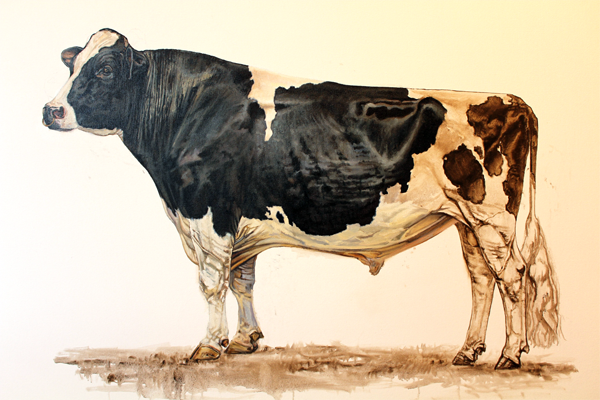
Ideal True Type Holstein Bull – The Beginning
A Brush with Great Expectations. Bonnie does acknowledge that there were some changes from her usual routine. “Normally I would start with some loose background and then get to the main subject. In this case, I painted the animals each to about a 75% completion point to be sure we could really focus on them against a white background.” There were other differences too. She shares her experience. “I would have to say that the size of these paintings did throw me for a loop. I have never painted so large, and I did underestimate the amount of time they would take. Also, any time you are working on a commission, there is a certain level of added stress, because you know in the end, it has to be exactly what the committee is expecting.”
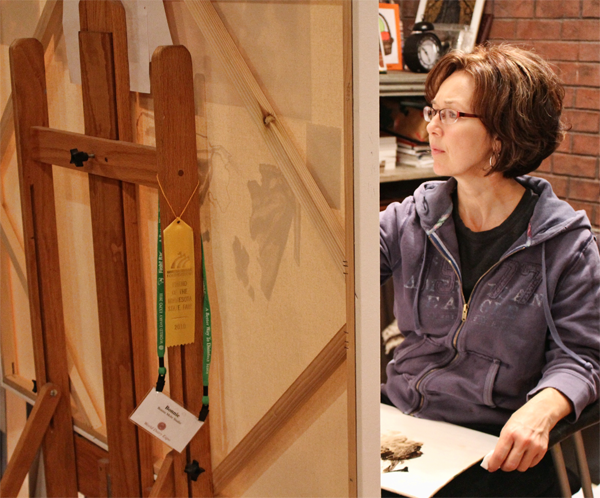
Bonnie Mohr – A love story
A love story. Looking back, Bonnie points out that the experience continued to evolve beyond the routine and developed into a very special project. A highlight of the commissioning came about when she made the decision to name the Bull and Cow, Romeo and Juliet. “Because I spent so much time with these paintings, they just seemed to come alive the more I worked on them. They became REAL to me, and it just seemed like the right thing to do…give them names.” Bonnie isn’t sure what came first: the naming of the subjects or the way the two paintings related, not only to her, but to each other. “They honestly seemed to connect to each other as well, and I think I accomplished my goal of making them seem like a real nice couple – as though they could be married. And so….thus came the names Romeo & Juliet.”
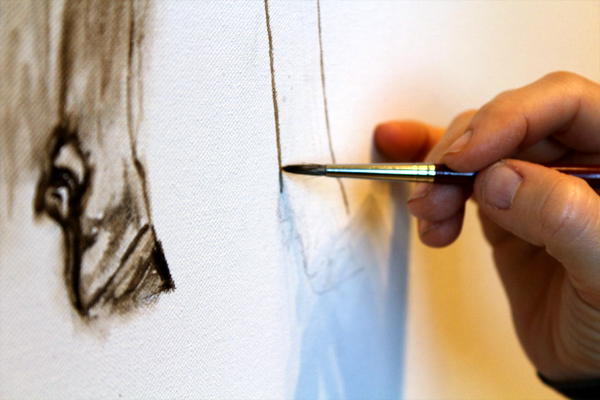
Picture Perfect
Picture Perfect. “I did have pictures of both cows and bulls to work from as I created these New Models. All of the animals I studied from and the pictures that I worked from, had key points of exceptional correctness, and it was very helpful for me to use them in creating the Models.” And so, from part science and part art, models were created for everyone to aspire to. Of course when we see Romeo and Juliet they appear to be right at home. “The committee and I collectively arrived at an outdoor, ‘anywhere USA’ setting, that resembled summer and a sense of pasture. We all felt this would be a typical and natural setting for the animals.”
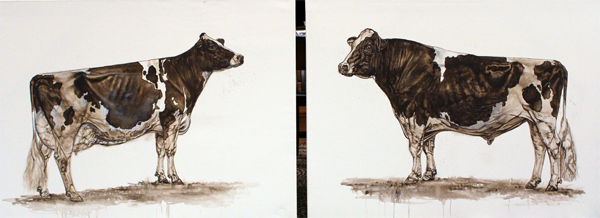
Romeo and Juliet
Where there any difficult moments with Romeo and Juliet? Seeing the twosome in all their glory it is hard to imagine that there were moments that were less than romantic but Bonnie assures us that there were. |” Absolutely. I have mentioned this before…and I’m not sure why, but Romeo almost seemed to paint himself. He just came together beautifully and I had very little trouble making him ‘work’. Juliet was my bigger challenge. Probably the mammary system and milk well veining is where I struggled the most. Too much veining, not enough veining, too much length to the fore udder and then too little, too small of a teat – make it bigger, and then a little plumper…..” Every cattle breeder can relate to Bonnie’s goal.
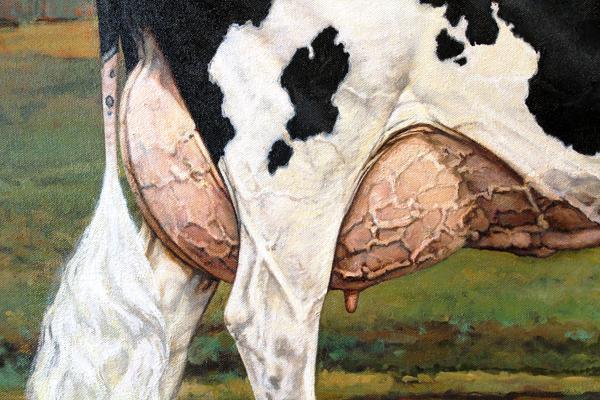
Desire for Perfection
Desire for Perfection
“The committee was great in their advice and direction…I personally as an artist just struggled with getting it just right.” It wasn’t easy. “When you study cow pictures….they can look a thousand different ways, depending on how closely the udder is shaved, how much sunlight they are photographed in, how much milk they have, etc., etc. And I wanted to try and paint the universal look, that every dairy farmer would be happy with…milky enough and yet strong in type, and so I would have to say this was definitely my biggest challenge. “In the same way that the total environment affects everyone who raises cattle, this project went beyond simply painting the models themselves. “ Making sure the backgrounds on the two paintings were fairly matched and similar was the other challenge, because they were so large and painted over a 5 month period. Every time you mix new paint, you have new colors…..so I had to go back and rematch or repaint some things to be sure they had a similar thread all the way through.” A labour of love.
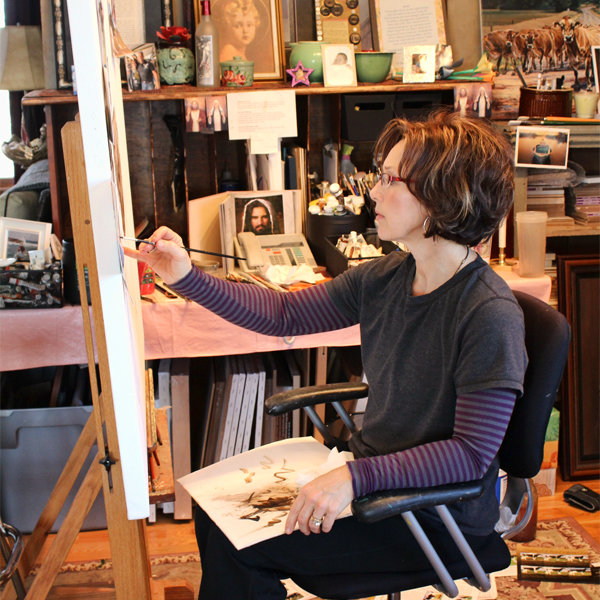
There’s love behind the Scenes Too!
There’s love behind the Scenes Too!
“My husband John has been the biggest influence in my career.” says Bonnie as she looks back on the inspiration for her successful vocation. “He has supported and believed in me from day 1. He believed in me more than I believed in myself some days. He is the reason I kept painting, even when I really wasn’t sure this whole ‘painting thing’ would work out. Other than that, I give God the thanks and credit for the skills I have been blessed with and the determination to know that hard work can pay off.”
THE BULLVINE BOTTOM LINE
And so, in painting the True Type Models, Bonnie crosses an item off of her Bucket List. “No doubt she will face her next goals with the same enthusiasm, “I will always love cows and will continue to think of new ways to paint them!” A Holstein Love Story continues ……..
Be sure to check out Bonnie Mohr studio’s Facebook page where you can help them reach 3,000 likes and be entered in a draw for a framed print valued at $200, as well as check out their website for more extraordinary fine art from rural America .

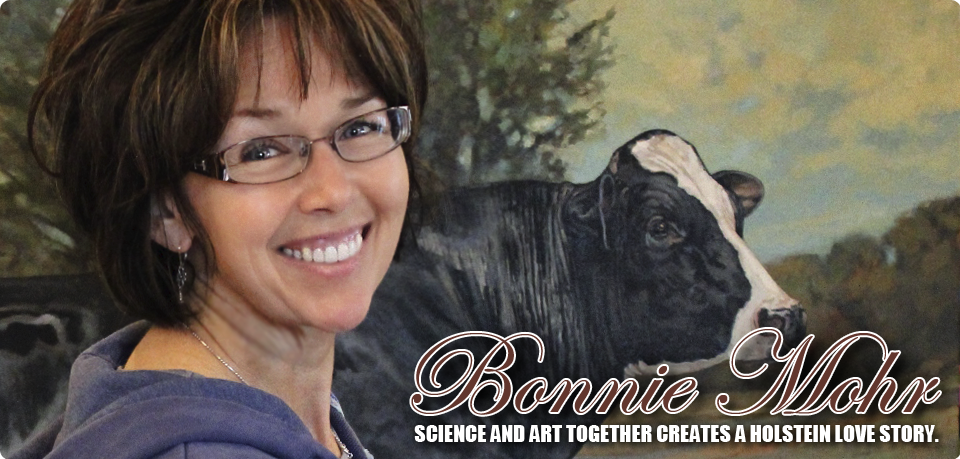















Leave a Reply
You must be logged in to post a comment.